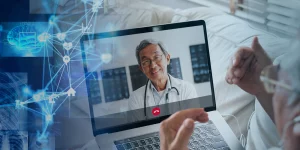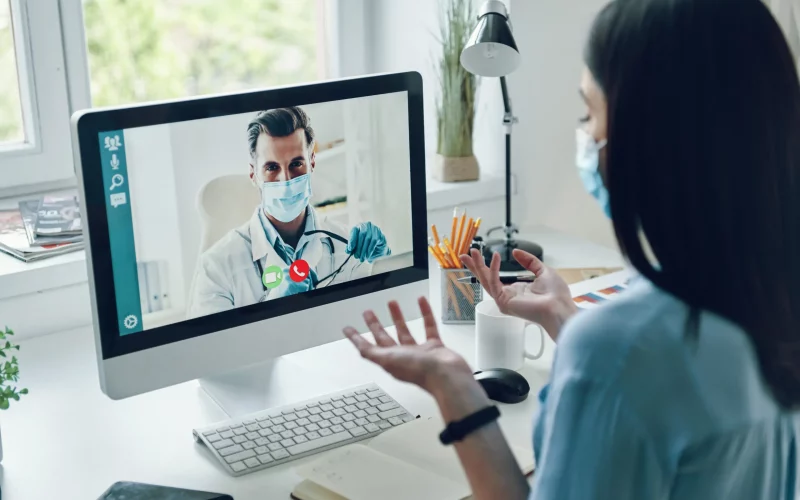Emerging telemedicine platforms

The landscape of telemedicine is rapidly evolving, with emerging platforms integrating advanced technologies to enhance healthcare delivery. One of the most significant advancements is the integration of Artificial Intelligence (AI) in telemedicine for diagnostics. AI algorithms can analyze vast amounts of patient data quickly and accurately, providing healthcare providers with valuable insights that can lead to early detection and precise diagnosis of various conditions. This integration not only improves the accuracy of diagnoses but also reduces the workload on healthcare professionals, allowing them to focus more on patient care.
Another critical aspect of emerging telemedicine platforms is the enhanced patient data security. With the increasing reliance on digital platforms for healthcare, ensuring the security of patient data has become paramount. Advanced encryption methods are now being employed to protect sensitive patient information from unauthorized access and cyber threats. These platforms are also incorporating biometric authentication, such as fingerprint and facial recognition, to ensure that only authorized personnel can access patient data. This dual approach of encryption and biometric security measures significantly enhances the overall security of telemedicine platforms, providing patients with peace of mind regarding the confidentiality of their health information.
Telemedicine in chronic disease management
Telemedicine is proving to be a game-changer in the management of chronic diseases by improving accessibility for patients. Individuals suffering from chronic conditions often require regular monitoring and follow-up, which can be challenging due to geographical and logistical barriers. Telemedicine bridges this gap by allowing patients to connect with healthcare providers from the comfort of their homes. This increased accessibility ensures that patients receive timely medical advice and interventions, which can significantly improve their overall health outcomes.
Moreover, telemedicine offers real-time monitoring for chronic conditions, which is crucial for effective disease management. Wearable devices and remote monitoring tools can continuously track vital signs and other health metrics, transmitting this data to healthcare providers in real time. This constant flow of information enables doctors to make informed decisions and adjust treatment plans promptly, reducing the risk of complications and hospitalizations. Real-time monitoring also empowers patients to take a more active role in managing their health, leading to better adherence to treatment plans and improved quality of life.
Telemedicine and mental health services
Telemedicine has also made significant strides in improving access to mental health services. Mental health issues often go untreated due to the stigma associated with seeking help and the lack of available services, especially in rural or underserved areas. Telemedicine breaks down these barriers by providing a convenient and discreet way for individuals to access mental health care. Patients can schedule virtual appointments with therapists and counselors, eliminating the need for travel and reducing the time and cost associated with in-person visits.
Additionally, telemedicine enables remote mental health consultations, which are particularly beneficial for individuals with mobility issues or those living in remote locations. Remote consultations allow mental health professionals to reach a broader patient base and provide continuous care regardless of the patient’s location. This approach not only ensures that more people receive the mental health support they need but also helps in early intervention and prevention of severe mental health crises.
Telemedicine education for healthcare providers

As telemedicine continues to grow, there is a pressing need to enhance telemedicine skills for healthcare providers. Medical professionals must be proficient in using telemedicine platforms and understanding the nuances of virtual consultations to deliver effective care. Training programs and continuing education courses being developed to equip healthcare providers with the necessary skills and knowledge to navigate telemedicine effectively. These programs cover various aspects, including the use of telemedicine technology, patient communication, and data security protocols.
Looking ahead, future advancements in telemedicine education are expected to focus on incorporating emerging technologies such as AI and machine learning. These advancements will enable healthcare providers to leverage AI-driven tools for diagnostics and treatment planning, further enhancing the quality of care delivered through telemedicine. Continuous education and training will ensure that healthcare providers remain up-to-date with the latest developments in telemedicine, ultimately benefiting patients through improved healthcare services.
Data security in telemedicine
Data security is a critical concern in telemedicine, and enhanced encryption methods being employed to safeguard patient information. Encryption ensures that data transmitted between patients and healthcare providers is secure and cannot be intercepted by unauthorized parties. Advanced encryption algorithms are used to encode patient data, making it virtually impossible for cybercriminals to decipher the information without the appropriate decryption key. This level of security is essential for maintaining patient trust and confidentiality in telemedicine services.
In addition to encryption, biometric authentication is being utilized to secure telemedicine patient data further. Biometric authentication methods, such as fingerprint scanning and facial recognition, provide an additional layer of security by ensuring that only authorized individuals can access sensitive patient information. These technologies are highly effective in preventing unauthorized access and reducing the risk of data breaches. By combining encryption with biometric authentication, telemedicine platforms can offer robust security measures that protect patient data and maintain the integrity of healthcare services.
Telemedicine and healthcare cost reduction
One of the most significant benefits of telemedicine is its potential to reduce healthcare costs by minimizing in-person visits. Traditional healthcare often involves significant expenses related to travel, hospital stays, and in-person consultations. Telemedicine eliminates the need for many of these in-person visits, allowing patients to receive medical advice and follow-up care remotely. This reduction in physical visits translates to lower overall healthcare costs for both patients and providers, making healthcare more affordable and accessible.
Furthermore, telemedicine enables cost-effective remote monitoring and follow-up care. Patients with chronic conditions or those recovering from surgery can be monitored remotely using wearable devices and telehealth platforms. This continuous monitoring reduces the need for frequent hospital visits and allows healthcare providers to detect and address potential issues early. By preventing complications and hospital readmissions, telemedicine not only improves patient outcomes but also significantly reduces healthcare costs associated with emergency care and hospital stays.
Patient engagement in telemedicine

Enhancing patient engagement in telemedicine consultations is crucial for the success of virtual healthcare. Effective communication and interaction between patients and healthcare providers are essential for accurate diagnosis and treatment. Telemedicine platforms are incorporating features such as video conferencing, secure messaging, and interactive tools to facilitate better patient-provider communication. These features enable patients to actively participate in their healthcare, ask questions, and provide valuable information about their symptoms and concerns.
Leveraging telemedicine for improved patient follow-up is another key aspect of patient engagement. Telemedicine allows for regular and convenient follow-up appointments, ensuring that patients adhere to their treatment plans and receive continuous care. Follow-up consultations scheduled more frequently and at times that convenient for patients, reducing the likelihood of missed appointments. This ongoing engagement helps in monitoring patient progress, addressing any issues promptly, and making necessary adjustments to treatment plans, ultimately leading to better health outcomes.
Global telemedicine initiatives
The expansion of telemedicine in underserved global regions is a promising development in improving global healthcare access. Many regions around the world lack adequate healthcare infrastructure and face significant barriers to accessing medical services. Telemedicine initiatives aim to bridge this gap by providing remote healthcare services to underserved populations. Through telemedicine, healthcare providers can offer consultations, diagnostics, and treatment to patients in remote and rural areas, ensuring that they receive the medical care they need.
The integration of AI in telemedicine for better diagnostics is also playing a crucial role in global telemedicine initiatives. AI-powered tools can analyze patient data and provide accurate diagnostic insights, even in regions with limited access to specialized healthcare professionals. This technology enables healthcare providers to deliver high-quality care and make informed decisions, regardless of their location. By leveraging AI and telemedicine, global healthcare initiatives can improve health outcomes, reduce disparities, and ensure that more people have access to essential medical services.










